Does Anybody Really Know What Time it Is?
When time changes, as it did last week, it can be difficult keeping track of what time it is and where. Some, most, or all of Europe exited daylight time a week before North America did this year. And a few areas within the United States don't observe daylight time at all. That means that time in Phoenix is the same as in Denver for about half of the year and the same as in Los Angeles for about half of the year. Fortunately, websites exist to help match your time with the time in other parts of the world. Some sites do a lot more than that, and I'd like to tell you about one of them.
Does anybody really know what time it is?
Does anybody really care?
(Chicago, October 1970)
If I could save time in a bottle
The first thing that I'd like to do
Is to save every day
Till eternity passes away
Just to spend them with you.
(Jim Croce, 1972)
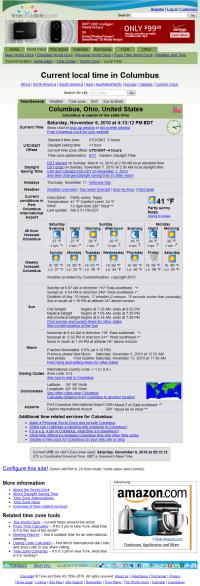 TimeAndDate.com goes far beyond the basic "what time is it there" site and includes a wealth of information that's useful if you need to work with someone who's located halfway around the world.
TimeAndDate.com goes far beyond the basic "what time is it there" site and includes a wealth of information that's useful if you need to work with someone who's located halfway around the world.
 Calling Australia from the US, for example, is a bit of a challenge because when it's during the business day in Australia, it's after offices are closed here. With a website such as this in your tool kit, you don't have to spend as much time finding out which areas use daylight time (and when the changes are effective) and then calculating the difference.
Calling Australia from the US, for example, is a bit of a challenge because when it's during the business day in Australia, it's after offices are closed here. With a website such as this in your tool kit, you don't have to spend as much time finding out which areas use daylight time (and when the changes are effective) and then calculating the difference.
 If I need to speak with someone in Bangalore, India, on November 20th when it's 9 in the morning in Bangalore, I know that I'll need to make the call at 9:30 pm on the 19th because Bangalore's time is UTC + 5:30 and the time in Columbus is UTC - 5:00 for a total difference of 10.5 hours. The website, helpfully, even offers "Find suitable time to call between Bangalore and Columbus" and the resulting color-coded list recommends the most appropriate times for both locations.
If I need to speak with someone in Bangalore, India, on November 20th when it's 9 in the morning in Bangalore, I know that I'll need to make the call at 9:30 pm on the 19th because Bangalore's time is UTC + 5:30 and the time in Columbus is UTC - 5:00 for a total difference of 10.5 hours. The website, helpfully, even offers "Find suitable time to call between Bangalore and Columbus" and the resulting color-coded list recommends the most appropriate times for both locations.
Time conversion used to be difficult. The easiest option would be to do what airlines do: Everybody uses UTC (Universal Coordinated Time/Temps Universel Coordonné), which purists will say should not be confused with Greenwich Mean Time (GMT)—also referred to as "Zulu". UTC and GMT are totally different but they are also exactly the same, give or take a few thousandths of a second.
If we want to get really lost in the weeds on this subject, UTC is based on International Atomic Time (TAI) with leap seconds added at irregular intervals to compensate for the Earth's slowing rotation. Leap seconds are used to allow UTC to closely track UT1, the mean solar time at the Royal Observatory, Greenwich. Unless you're a scientist whose concerned with astonishingly precise time measurements, the difference is unimportant.
If TimeAndDate.com did nothing more than display the time of day and date for various locations on the planet, it would be useful but common. It's the sites other features that make it a standout.
To Register or Not to Register
The site allows you to establish viewing preferences, but these will be lost if you delete the site's cookie from your browser and the customization won't be available if you use the site from another computer.
To avoid those problems, you can register. There's no charge, the site's owners say they won't sell your e-mail address, and your customizations will work from any computer. In addition, more customizations are possible. So I registered.
When you register, you can specify or omit a password. If you don't set a password, anyone who knows your e-mail address can use or change your settings. The site recommends that you "use another password here than you use for other systems." I would take that warning to indicate that password storage may not be particularly secure. Use a password here that you don't use elsewhere.
I thought that I'd take a look at McMurdo Station in Antarctica and its presence confirms that TimeAndDate.com has information for all continents on the planet. How much information is available varies from one locale to another.
The temperature was 22 degrees and the sky was overcast at McMurdo and the weather for the next several days should be generally clear with highs between 12 and 20, lows from 2 to -17. Currently, the sun is up all day and the moon is up all day.
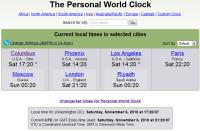 The ability to create a personal world clock is useful. I have set up a page that shows the time in Columbus along with the current time in Arizona, California, Paris, Moscow, London, and Saudi Arabia.
The ability to create a personal world clock is useful. I have set up a page that shows the time in Columbus along with the current time in Arizona, California, Paris, Moscow, London, and Saudi Arabia.
In some ways, TimeAndDate.com reminds me of Google Earth. It can be an amazing time sink, but you'll be exposed to a wealth of information that's interesting (even if it's not always immediately useful), including the sun calculator, the moon calculator, and moon phases: On Saturday, November 6, the sun rose at 8:07 and set at 18:24. (Yes, I prefer the 24-hour clock representation because there's never a question about morning or afternoon.) On Sunday, November 7, when (on Standard time), the sun rises at 7:08 and sets at 17:23.
I also know that the next full moon will be on November 21 and that a lunar eclipse will occur that day, the final eclipse of 2010. According to TimeAndDate.com, "It will be visible to observers in North America and western South America. The eclipse's total phase lasts for 72 minutes. The total eclipse begins at 07:40:47 UT and the point of the greatest eclipse occurs at 08:16:57 UT."
Just what I need: Another time sink!
Dreamweaver Brings New Power to Web Development
A long-time friend who uses a very old version of Dreamweaver to maintain his site (several hundred pages) said that he's thinking of starting to maintain his code in Bare Bones Software's TextWrangler but wondered if he would be better off upgrading to the latest Dreamweaver version instead or possibly switching to WordPress. He asked for my opinion. You will not be surprised to learn that I had one.
I've used every version of Dreamweaver from Macromedia version 2 (I think I skipped the original and was still using Microsoft's Front Page back then) up to and including Adobe CS5. I have never seen any serious problems. Much of the structure of the program is controlled by Javascript, which can be slow (it's interpreted, not compiled) but overall there's nothing I would consider other than Dreamweaver at this point. At that point, I planned to suggest that he read my review of Dreamweaver CS5.
That's when I found that I didn't have one. Somehow I had managed to write and talk about most of the other CS5 components, but not Dreamweaver—the one that I've used for the longest!
As for writing your own HTML in a text editor, I asked "Why?" I can't think of any good reason to waste time that way, particularly with the coming HTML5 (replacement for the much anticipated but never realized XHTML). Although HTML5 isn't as punitive as XHTML would have been, you still need to create properly organized code and it's very easy to make silly mistakes in a text editor.
Because Dreamweaver's CSS tools are much better than they used to be, I find that I use a text editor (UltraEdit, which is equivalent to Bare Bones Edit on the Mac—TextWrangler's big brother) much less for CSS than in the past. I do still use UltraEdit whenever I have to do anything with Javascript, though.
I use WordPress for TechByter:TODAY but I would never consider it for a site such at TechByter.com because it applies far too many constraints on how things may be presented. I want the control. I couldn't recommend WordPress for his site, either, because it's really intended more as a blogging tool.
If you want to create a basic WYSIWYG site with few constraints and on a budget, I can recommend Xara Web Designer, which I wrote about in June.
"But you mentioned several hundred pages," I said. "TechByter now has several thousand pages. Every year or two, I change the basic look and feel, update the underlying technology, and such. The huge advantage Dreamweaver offers is the ability to create templates that can maintain the header and footer information, menus, and other elements that are consistent from page to page. In addition, there are Library items. These are chunks of text or graphics that you want to be the same on various pages. Sometimes Library items are included in a Template. Sometimes they're included on individual pages."
Between these two extremely powerful features, Dreamweaver makes changes that might otherwise take hours (or days) in just a minute or two.
A website designer I know once took over a website that had been created for a Los Angeles business by a graphic designer. The site was excellent visually, but the graphic designer knew little about HTML. The client's phone number changed twice within 2 years and the website designer had to manually edit each of the approximately 500 pages in the site. This was boring for the website designer and expensive for the client so the designer asked for permission to modify the site—to retrofit it with Dreamweaver Templates and Libraries. Since then, there have been several other site-wide changes that could be processed and tested in 1 hour instead of 2 days.
Dreamweaver Is Not for Wimps
A review of Dreamweaver CS5 by PC Magazine said "Adobe's Web design program Dreamweaver digs deeper with its CS5 version—at least for advanced users. But beginners may need or want more help than Adobe's increasingly complex tool is primed to provide." Although this is true, it should also be self evident. Expecting a complex tool to be child's-play to master makes as much sense as expecting the average rush-hour Chevy driver to hop into a car at the Indianapolis 500 and win on the first try.
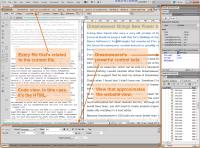 Tools are complex. It takes time to learn how to use them and if you're not willing to invest that time, then you have no business trying to use them.
Tools are complex. It takes time to learn how to use them and if you're not willing to invest that time, then you have no business trying to use them.
It seems to me that there are 2 kinds of people who will be attracted to purchase Dreamweaver: Those who have been using the program for a while and who want to upgrade to the latest version and those who have learned how to operate Dreamweaver in design school and who need the program for their work.
The average office worker shouldn't be in the market for a program such as this any more than the average office worker would be in the market for a 4-color web press to print the monthly newsletter. Dreamweaver is for designers. If the designer is asked to create a site that the average office worker can update, the recommendation should be to develop in Dreamweaver and outfit the office workers with Adobe Contribute, an application that allows them to modify the site's content without wrecking the design.
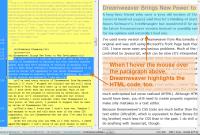 For those who know their way around HTML and CSS, Dreamweaver's Inspect Mode gives you a visual representation of borders, margins, and paddings that surround elements (the box model). Dreamweaver color codes the various pieces so you can quickly see where any problems are. And there's Live View that goes beyond the traditional WYSIWYG view and shows you what the page will actually look like in the browser and, beyond that, enables site navigation and, if you've enabled a Web server on your local machine, displays server-side function and dynamic data.
For those who know their way around HTML and CSS, Dreamweaver's Inspect Mode gives you a visual representation of borders, margins, and paddings that surround elements (the box model). Dreamweaver color codes the various pieces so you can quickly see where any problems are. And there's Live View that goes beyond the traditional WYSIWYG view and shows you what the page will actually look like in the browser and, beyond that, enables site navigation and, if you've enabled a Web server on your local machine, displays server-side function and dynamic data.
Dreamweaver CS5 supports Subversion, an open-source version control system, so that when multiple site designers are working on a single site, each can know which files the others are working on. Additionally, if you're using Dreamweaver to maintain sites based on Joomla, WordPress, or Drupal, you'll find that Dreamweaver has code hinting for these platforms.
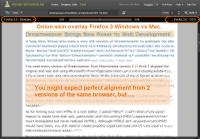 Because browsers are at best inconsistent, one very welcome feature is integration with Adobe's CS Live BrowserLab. Now you can preview your site in Firefox (version 2 and above), Internet Explorer (versions 6 through 8), Safari (3 and above), and Chrome 3—all without leaving Dreamweaver.
Because browsers are at best inconsistent, one very welcome feature is integration with Adobe's CS Live BrowserLab. Now you can preview your site in Firefox (version 2 and above), Internet Explorer (versions 6 through 8), Safari (3 and above), and Chrome 3—all without leaving Dreamweaver.
 Bottom Line: "It's in there."
Bottom Line: "It's in there."
(Prego spaghetti sauce commercial from the mid 1980s.)
Dreamweaver continues to be the Web development application that comes with all the tools needed to create first-class sites. Adobe has done an excellent job of integrating Dreamweaver into the Creative Suite family and each new version further solidifies the overall suite's position at the premiere development tool for print and Web designers.
For more information, visit the Adobe Dreamweaver website.
Harry Potter and the Deathly Identity Snatch
It seems that every time a long-expected blockbuster movie arrives, so does a flurry of criminal activity designed to steal your personal information, your identity, and your cash. The first of the final two-movie episode of the Harry Potter series (which is to say the penultimate film), Harry Potter and the Deathly Hallows, will be in theaters starting November 19. For the scammers this as a real Thanksgiving present, but it's easy not to be a turkey. Just practice not clicking.
If somebody sends you a message offering a website where you can see the movie for free, your best move is not to click the link. As obvious as this seems, sometimes we forget. Or our kids forget. Or maybe they don't know any better, so it's up to parents to educate them.
PC Tools, a publisher of antivirus, anti-spyware, and security applications says that movie premieres such as this one are commonly used as bait by criminals.
You might follow a link to a special offer that will, of course, require you to fill out an application blank with a lot of personal information. Or you might be offered a Harry Potter tool bar that's actually a malicious application that monitors keystrokes and steals user names and passwords. Or you may be told that you can win something (a computer, an Ipad, and Iphone, etc.) or that because you're in a special group you qualify to receive something for free. You find out later that the "free" item requires you to fill out many forms and agree to a lot of other special offers. By the time you quality for the "free" item (if you ever do) you'll have paid far more than it's worth.
Here are some examples of what you might encounter. Please note that these images have been provided by PC Tools and that all URLs have been obliterated.
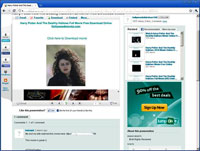 This site offers to allow you to download the movie. You may think that you're putting one over on Warner Brothers. In fact, you'll be giving some fraudster permission to take over your computer and steal information from you. This could be a very expensive movie "ticket".
This site offers to allow you to download the movie. You may think that you're putting one over on Warner Brothers. In fact, you'll be giving some fraudster permission to take over your computer and steal information from you. This could be a very expensive movie "ticket".
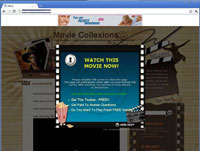 Movie "Collexions". This spelling-challenged site wants you to complete a "survey" to "unlock" the page.
Movie "Collexions". This spelling-challenged site wants you to complete a "survey" to "unlock" the page.
Yeah. Good luck with that.
 Or you might end up at a site that offers you a "free Ipad just for joining". The site is free. The Ipod is free. How does that business model work? ("We lose money on every sale, but we make it up on volume!")
Or you might end up at a site that offers you a "free Ipad just for joining". The site is free. The Ipod is free. How does that business model work? ("We lose money on every sale, but we make it up on volume!")
Sorry. It doesn't work that way. There is no such thing as a free Ipad.
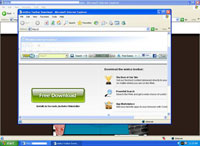 This site wants me to download a free tool bar.
This site wants me to download a free tool bar.
Why? Free tool bars are usually overpriced. Avoid.
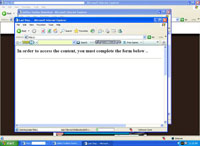 Of course you can't see the movie. The fraudster doesn't even have the movie, but they'll keep stringing you along.
Of course you can't see the movie. The fraudster doesn't even have the movie, but they'll keep stringing you along.
"Just fill out the next form and this time we'll really show you the movie. Honest. Trust us."
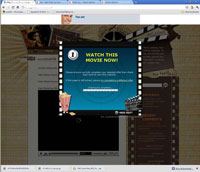 And here's where the story ends.
And here's where the story ends.
"If this page is still locked," it says, "try another offer." Or, "Hey, sucker, did you hear that they took 'gullible' out of the dictionary?"
The key thing to remember is that anyone who offers you a free copy of a film that's not yet even in theaters is by definition a crook.
If you want real information about the upcoming Harry Potter and the Deathly Hallows movie, good sites to check include:
- The official Warner Brothers website.
- The Internet Movie Database.
- Wikipedia.
- Apple's Itunes site.
- The author's website.
As for those e-mails from fraudsters—just don't click.
Short Circuits
Do E-Book Readers Need Color?
A couple of months after I decided to opt for the Kindle and its high-quality monochrome screen, Barnes and Noble has released a color Nook. This raises the question (which is not to say that it "begs the question" because it doesn't) of whether color is necessary for these devices. It may depend on what you read.
I can't see the advantage of color for most of what I read: Fiction and non-fiction books that, if they have pictures, will have black and white pictures. Text on a color screen will be less crisp and clear than monochrome text because of the way RGB displays work. So for me, color isn't a big deal.
I doubt that "coffee-table" books will be big hits on portable devices but comic books (aka "graphic novels") might.
For me, the advantage of minimal power use (leading to long battery life) and sharp displays that can be read in sunlight tip the balance in favor of monochrome. But color is coming. It will be an important addition for children's books and probably for cook books. I still think that art books are a long shot.
A Chinese company says that it will soon use technology from E Ink, the company whose black-and-white technology is used in virtually all of the current e-book readers, to create a color display.
It's true that Barnes and Noble has announced its color Nook, but this device is based on RGB technology. It will use more power and the display will be less clear than the devices based on E Ink. But color is clearly something that will sell.
Those who have seen the coming crop of color readers say the colors are muted and the display isn't particularly crisp and clear. That's because the system uses a black-and-white display that is overlaid with a color filter. So long battery life is maintained and the display can be read in bright light.
The Chinese company, Hanvon, is the primary seller of electronic readers in China, but the company is essentially unknown outside China. The company's color product will have a screen that's just slightly less than 10 inches diagonally for less than $500 and will include both Wi-Fi and wireless 3G connectivity.
NY Times Takes E-Books Seriously
In a move that clearly illustrates the ascendency of electronic books, the New York Times reported this week, in an article by reporter Julie Bosman, that the New York Times will begin publishing e-book best-seller lists in 2011. Is there an echo in here? This is a paper that doesn't report on its own activities very often, so this must be a particularly ground breaking event. That or it was a slow news day.
According to the article, the newspaper has published best-seller lists since 1935 and these are "widely considered the industry standard" although the article allowed that lists are "also published by Publishers Weekly, a trade publication, and newspapers including The Los Angeles Times and USA Today."
The newspaper will compile the rankings from weekly data provided by publishers, chain bookstores, independent booksellers, and online retailers, "among other sources". Other sources? Who else might sell books? And will this take into account books offered for free by retailers such as Amazon.com or books lent by libraries?
One of the other sources will be RoyaltyShare, "a San Diego-based company that tracks data and aggregates sales information for publishers." RoyaltyShare will "offer an additional source of independent corroboration."
According to the article, e-book sales have risen steeply in 2010 and this is attributed to Amazon's Kindle and Apple's Ipad. "According to the Association of American Publishers, which receives sales data from publishers, e-book sales in the first nine months of 2010 were $304.6 million, up from $105.6 million from the same period in 2009." The Times points out, somewhat redundantly, that this is "a nearly 190 percent increase."
To accommodate the new list, the New York Times will modify the book review section of the Sunday newspaper. There are already 14 lists, "including those for fiction, nonfiction and advice books in hardcover and paperback, as well as children's books and graphic books." So this will be number 15.


 The author's image: It's that photo over at the right. This explains why TechByter Worldwide was never on television, doesn't it?
The author's image: It's that photo over at the right. This explains why TechByter Worldwide was never on television, doesn't it?
